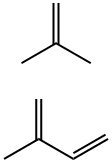Polyisobutylene , Molecular weight 2400 , 9003-27-4
CAS NO.:9003-27-4
Empirical Formula: C4H8
Molecular Weight: 56.1063
MDL number: MFCD00084436
EINECS: 618-360-8
| Pack Size | Price | Stock | Quantity |
| 25g | RMB30.40 | In Stock |
|
| 100g | RMB77.60 | In Stock |
|
| 500g | RMB261.60 | In Stock |
|
| 2.5kg | RMB893.60 | In Stock |
|
| others | Enquire |
PRODUCT Properties
| Melting point: | 54-56 °C |
| Boiling point: | 300 °C |
| Density | 0.92 g/mL at 25 °C (lit.) |
| Tg | -61 |
| Tg | -62 |
| Tg | -64 |
| Tg | -75 |
| refractive index | n |
| Flash point: | >212 |
| Flash point: | >482 |
| form | slab/chunk |
| color | colorlessor white |
| Stability: | Stability Combustible. Incompatible with strong oxidizing agents. |
| InChI | InChI=1S/C4H8/c1-4(2)3/h1H2,2-3H3 |
| InChIKey | VQTUBCCKSQIDNK-UHFFFAOYSA-N |
| SMILES | C=C(C)C |
| Surface tension | 33.6mN/m at 20°C |
| EPA Substance Registry System | Polyisobutylene (9003-27-4) |
Description and Uses
polyisobutene (hydrogenated) is an emollient.
Polyisobutylene, sometimes called butyl rubber, and other times PIB, is a vinyl polymer. It's very similar to polyethylene and polypropylene in structure, except that every other carbon is substituted with two methyl groups. It is made from the monomer isobutylene, by cationic vinyl polymerization.
Polyisobutylene is a synthetic rubber, or elastomer. It's special because it's the only rubber that's gas impermeable. That is, it's the only rubber that can hold air for long periods of time. You may have noticed that balloons will go flat after a few days. This is because they are made of polyisoprene, which is not gas impermeable. Because polyisobutylene will hold air, it is used to make things like the inner tubes, liner layers of tires, and the inner liners of basketballs.
Safety
| Safety Statements | 24/25 |
| WGK Germany | 3 |
| RTECS | UD1010000 |
| TSCA | TSCA listed |
| HS Code | 39022000 |
| Hazardous Substances Data | 9003-27-4(Hazardous Substances Data) |






